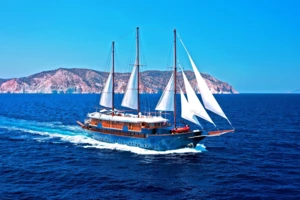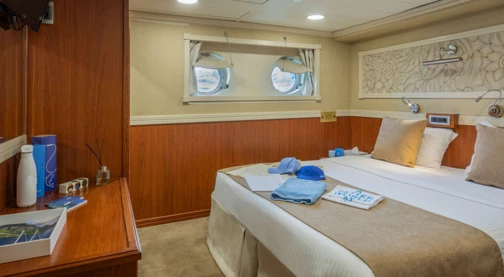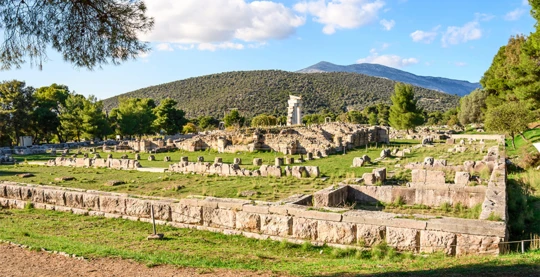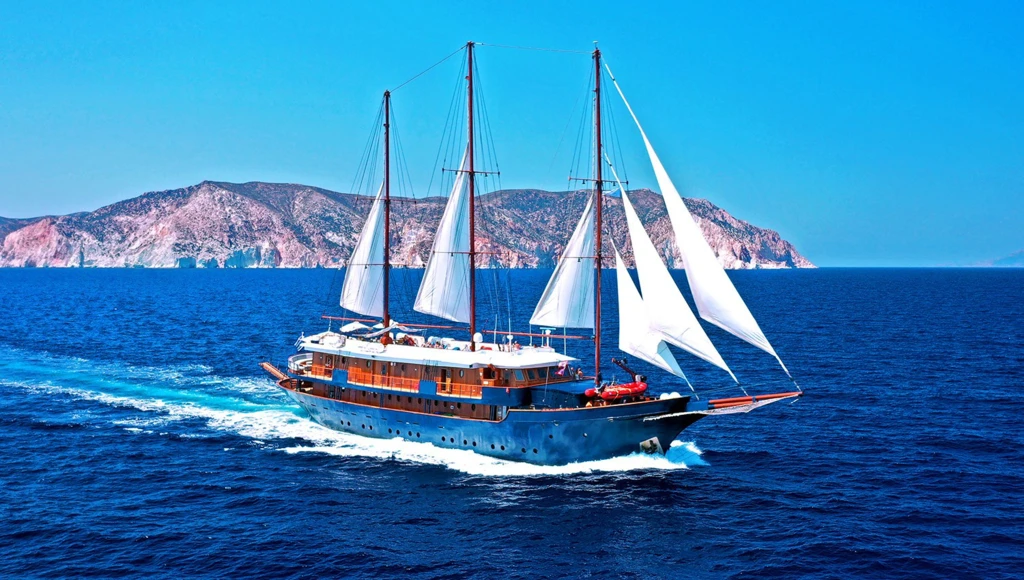

A sailing odyssey to discover the heritage of ancient Greece and Byzantium
Main characteristics
Type of boat: traditional ship
Number of cabins: 25
Maximum capacity: 49 travelers
Crew members: 18
Comfort facilities
Cabs
Cat A - Upper deck - Double bed or twin beds
Capacity: 2 Beds maximum
This bright cabin of about 13 m2 on the upper deck is equipped with air conditioning, ventilation, safe, mini fridge, TV, CD and DVD player, wardrobe, mirror. The bathroom is independent and equipped with toilet and shower, bathroom products and a hair dryer.
This bright cabin of about 13 m2 on the upper deck is equipped with air conditioning, ventilation, safe, mini fridge, TV, CD and DVD player, wardrobe, mirror. The bathroom is independent and equipped with toilet and shower, bathroom products and a hair dryer.
952.jpg/504z277-webp)
952.jpg/504z277-webp)
952.jpg/504z277-webp)
952.jpg/504z277-webp)
Cat B - Lower deck - Flexible configuration
Capacity: 2 Beds maximum
This wood-clad cabin with 2 portholes opens onto the lower deck and is equipped with air conditioning, safe, mini-fridge, TV, CD and DVD player, closet and mirror. The bathroom is independent and equipped with toilet and shower, bathroom products and hairdryer.
This wood-clad cabin with 2 portholes opens onto the lower deck and is equipped with air conditioning, safe, mini-fridge, TV, CD and DVD player, closet and mirror. The bathroom is independent and equipped with toilet and shower, bathroom products and hairdryer.

952.jpg/504z277-webp)
Cat C - Lower deck - Double bed or twin beds
Capacity: 2 Beds maximum
This wood-clad cabin with 2 portholes opens onto the lower deck and is equipped with air conditioning, safe, mini fridge, TV, CD and DVD player, wardrobe, mirror. The bathroom is independent and equipped with toilet and shower, bathroom products and a hair dryer.
This wood-clad cabin with 2 portholes opens onto the lower deck and is equipped with air conditioning, safe, mini fridge, TV, CD and DVD player, wardrobe, mirror. The bathroom is independent and equipped with toilet and shower, bathroom products and a hair dryer.
952.jpg/504z277-webp)

NB: The photos, information and visuals presented are not contractually binding. The indicated itinerary and program may be modified without prior notice, depending on the weather conditions or for technical reasons (decision of the captain). Sailing times may vary depending on sea and weather conditions.
Sailing itineraries

Athens Epidaurus
Embarkation between 2-3 pm. Enjoy a welcome drink and meet your crew and fellow passengers. Sail... see+
Breakfast
Lunch
Dinner

Epidaurus Nauplio
We leave our ship early in the morning to drive to ancient Epidaurus for our optional excursion.... see+
Optional services: Excursion in ancient Epidaurus, see+
Breakfast
Lunch
Dinner

Nauplio Mycenae Monemvasia
After a short walking tour of Nafplion, drive through the colorful city and the beautiful... see+
Optional services: Discovering Nafplion and Mycenae, see+
Breakfast
Lunch
Dinner

Monemvasia Gythion
After a short walking tour of Nafplion, drive through the colorful city and the beautiful... see+
Optional services: Excursion to Mani and the Diros Cave, see+
Breakfast
Lunch
Dinner

Gythion Pylos
Pylos is a picture-perfect seaside town on the southwest corner of the Peloponnese. In 1827 a fleet... see+
Optional services: Nestor’s Palace and the Enchanting Navarino Landscape, see+
Breakfast
Lunch
Dinner

Pylos Katakolon Itea
Early morning arrival in port of Katakolon. We will disembark around 7:00 a.m. and an optional... see+
Optional services: Excursion to Olympia, see+
Breakfast
Lunch
Dinner

Itea Delphi Crossing the Corinth Canal Athens
Morning optional excursion to Delphi, one of the most revered sites from the ancient world. We will... see+
Optional services: Excursion to Delphi, see+
Breakfast
Lunch
Dinner

Athens
Disembarkation at 8:30 - 9am after breakfast.
Breakfast
Lunch
Dinner
Included
The price includes
English-speaking cruise coordinator
Unlimited water, tea and coffee
Use of fishing and snorkelling equipment
English-speaking crew and guide
Meals included in the program
The price does not include
Beverages other than those listed
Excursions or services on land other than those mentioned
Personal expenses and tips
WIFI
Activities not included in the program
Meals not included in the program
Port taxes - Compulsory : 345€ / person
Further information
Even if the boat is equipped with sails, it will mainly be powered when the conditions are too pitch for the sails to be used
Please note that this cruise may be cancelled and refunded due to insufficient numbers of participants, up to 60 days before embarkation
Optional services
Flights not included in the program are available on request
Activities and excursions on request see+
Activities

We leave our ship early in the morning to drive to Ancient Epidaurus, known throughout ancient Greece as a healing sanctuary and often regarded as the birthplace of modern medicine. It is reputed to be the birthplace of Asclepius, son of Apollo, and is famous... see+
Not included $106 / pers.

After a short drive through the colorful town of Nafplion and the fertile Argolis countryside, you’ll arrive at Mycenae, a major center of Greek civilization. The city’s importance, which Homer described as “rich in gold”, began around 1650 BC and... see+
Not included $106 / pers.

Ancient Gythion was inhabited during prehistoric times and later the Spartans used it as a port, enlarging the natural harbour and making Gythion their naval base. Leaving Gythion, we will cross the scenic Mani Peninsula to reach Diros and visit the... see+
Not included $113 / pers.

Pylos town sits on the backside of stately Navarino Bay, site of several famous naval battles:
In Antiquity, between Spartans and Athenians during the Peloponnesian conflict. In 1827, a fleet of Venetians and other city-states defeated the Ottoman fleet in... see+
In Antiquity, between Spartans and Athenians during the Peloponnesian conflict. In 1827, a fleet of Venetians and other city-states defeated the Ottoman fleet in... see+
Not included $112 / pers.

We will disembark the ship early morning in the port town of Katakolo and travel by bus to Olympia, one of the most famous and important sites in the ancient world. Olympia is revered as the birthplace of the Olympic Games and was the greatest Pan-Hellenic... see+
Not included $165 / pers.

Itea is best known as the gateway to Delphi, one of the most revered sites of the ancient world. We will disembark the ship early this morning to reach the archaeological site. Unlike other locations in Greece, Delphi is built on the side of a mountain,... see+
Not included $106 / pers.
Information about the partner
Commercial history with Filovent
- Filovent partner since 2024
- Last booking with this partner in October 2025
- 18 bookings with this partner

















